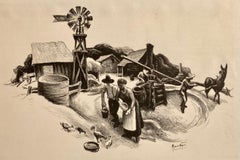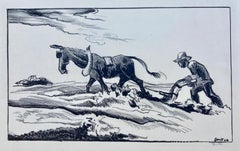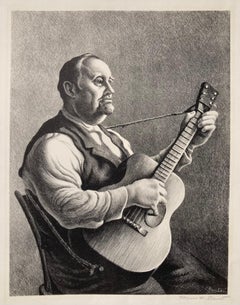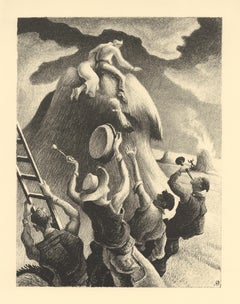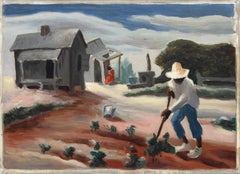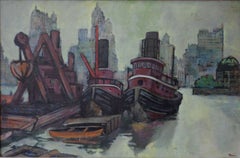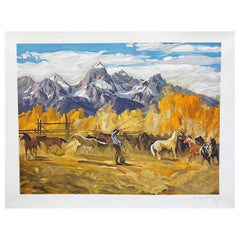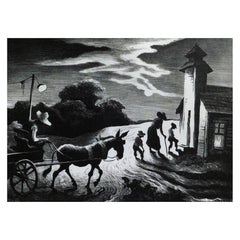Thomas Hart Benton Art
American, 1889-1975
Thomas Hart Benton was born in Neosho, Missouri on April 15, 1889. Even as a boy, he was no stranger to the "art of the deal" or to the smoke-filled rooms in which such deals were often consummated. His grandfather had been Missouri's first United States Senator and served in Washington for thirty years. His father, Maecenas Benton, was United States Attorney for the Western District of Missouri under Cleveland and served in the United States House of Representatives during the McKinley and Theodore Roosevelt administrations. Benton's brother, Nat, was prosecutor for Greene County, Missouri, during the 1930s.
As soon as he could walk, Benton traveled with his father on political tours. There he learned the arts of chewing and smoking, and while the men were involved in their heated discussions, Benton delighted in finding new cream colored wallpaper on the staircase wall, at the age of six or seven, and drew in charcoal his first mural, a long multi-car freight train.
As soon as he was eighteen, even though his father wanted him to study law, Benton left for Chicago where he studied at the Art Institute during the years 1907 and 1908. He continued his studies in Paris, where he learned delicious wickedness, aesthetic and otherwise.
Once back home, he became the leader of the Regionalist School, the most theatrical and gifted of the 1930s muralists and as Harry Truman described him,"the best damned painter in America."
Detractors said that Benton was "a fascist, a communist, a racist and a bigot"; the ingenious structure, powerful use of modeling and scale and the high-colored humanity of the murals and easel paintings are retort enough. He was a dark, active dynamo, only 5 ft., 3 1/2 in. tall. He was outspoken, open, charmingly profane; he had a great mane of hair and a face the texture of oak bark. He wore rumpled corduroy and flannel, and walked with the unsteady swagger of a sailor just ashore. He poured a salwart drink, chewed on small black cigars and spat in the fire.
Benton was once described as the "churlish dean of regionalist art." If you listened to a variety of art authorities, you would find them equally divided between Harry Truman's assessment of Benton as "the best damned painter in America" and Hilton Kramer who proclaimed Benton "a failed artist."
The East Coast art establishment tended to regard Benton as memorable for one reason only: he was the teacher of Jackson Pollock.
Benton was married in 1922 to Rita, a gregarious Italian lady, and they had a daughter and a son. At the height of his fame in the 1940s, Benton bungled the buy-out he was offered by Walt Disney and went his own way, completing his last mural in 1975 in acrylics the year of his death.
He died in 1975.(Biography provided by Gallery of the Masters)
to
23
6
29
26
9
8
6
1
Kansas Farmyard / Missouri Farmyard
By Thomas Hart Benton
Located in Santa Monica, CA
THOMAS HART BENTON (1889-1975)
MISSOURI FARMYARD, 1936 (Fath 10) AKA KANSAS FARMYARD
Lithograph as published by Associated American Artists. Edition 250. Signed in pencil and in the...
Category
1930s American Realist Thomas Hart Benton Art
Materials
Lithograph
PLOUGHING IT UNDER
By Thomas Hart Benton
Located in Santa Monica, CA
THOMAS HART BENTON (1889-1975)
PLOUGHING IT UNDER (aka Ploughing) 1934 (Fath 8)
Original lithograph, signed in pencil. Edition of 250 as published by Associated American Artists (AA...
Category
1930s American Modern Thomas Hart Benton Art
Materials
Lithograph
COMING ROUND THE MOUNTAIN
By Thomas Hart Benton
Located in Santa Monica, CA
THOMAS HART BENTON (1889-1975)
COMING ROUND THE MOUNTAIN (MISSOURI MUSICIANS) 1931 (Fath 4)
Lithograph, signed in pencil. Although Fath indicates an edition of 75, it is numbered ...
Category
1930s American Realist Thomas Hart Benton Art
Materials
Lithograph
HYMN SINGER / THE MINSTREL / BURL IVES -- Large Benton
By Thomas Hart Benton
Located in Santa Monica, CA
THOMAS HART BENTON (1890- 1975)
HYMN SINGER / THE MINSTREL (Portrait of Burl Ives) 1950 (Fath 74)
Lithograph signed with full signature “Thomas H. Benton” A large image, 15 ¾ x 12 i...
Category
1950s American Realist Thomas Hart Benton Art
Materials
Lithograph
lithograph
By Thomas Hart Benton
Located in Henderson, NV
Medium: lithograph. Executed by Thomas Hart Benton to illustrate the Lynn Riggs classic "Green Grow the Lilacs" and printed in 1954 in a limited edition of 1500 by the University of ...
Category
1950s Thomas Hart Benton Art
Materials
Lithograph
Hoeing Cotton
By Thomas Hart Benton
Located in Palm Desert, CA
“Hoeing Cotton” is an oil on tin painting by Thomas Hart Benton, painted in 1932. The painting size is 9 1/8 x 13 inches. The framed size is 15 1/4 x 19 x 1 3/4 inches. The work is s...
Category
Early 20th Century American Realist Thomas Hart Benton Art
Materials
Oil
lithograph
By Thomas Hart Benton
Located in Henderson, NV
Medium: lithograph. Executed by Thomas Hart Benton to illustrate the Lynn Riggs classic "Green Grow the Lilacs" and printed in 1954 in a limited edition of 1500 by the University of ...
Category
1950s Thomas Hart Benton Art
Materials
Lithograph
lithograph
By Thomas Hart Benton
Located in Henderson, NV
Medium: lithograph. Executed by Thomas Hart Benton to illustrate the Lynn Riggs classic "Green Grow the Lilacs" and printed in 1954 in a limited edition of 1500 by the University of ...
Category
1950s Thomas Hart Benton Art
Materials
Lithograph
Study of a Male Nude (Original Thomas Hart Benton, Signed & Authenticated)
By Thomas Hart Benton
Located in New Orleans, LA
A rare ORIGINAL and authenticated pen-and-ink drawing with a fine provenance, and a wonderful drawing at that, by legendary American Scene artist Thomas Hart Benton. Though we are most familiar with his WPA-era paintings of rural Midwestern scenes, his drawings are less familiar - but they dramatically demonstrate his superb draftsmanship. The work as framed measures 19.5" x 15.25"; unframed, the artwork measures 14.5" x 10.25". Fine condition. Comes with a copy of a certificate of authenticity: provenance: Savor Gallery, New York, NY; Parke-Bernet Galleries, New York, NY. Proudly presented by Guy Lyman Fine Art, New Orleans
The following bio information was taken from AskArt:
"Important realist painter of the regional school, muralist, printmaker, teacher, writer.
A member of the famous Missouri political family, Tom Benton...
Category
Mid-20th Century Thomas Hart Benton Art
Materials
Ink
INSTRUCTION
By Thomas Hart Benton
Located in Santa Monica, CA
THOMAS HART BENTON (1889-1975)
INSTRUCTION 1940 (Fath 41)
Lithograph, signed edition of 250 as published by Associated American Artists.
10 ¼” x 12 ¼”. Full margins, deckle edges....
Category
1940s American Realist Thomas Hart Benton Art
Materials
Lithograph
'Instruction' 1940
By Thomas Hart Benton
Located in Pembroke Pines, FL
THOMAS HART BENTON (American, 1889-1975)
"Instruction", 1940
Lithograph on paper
10-1/4 x 12-1/4 inches (26.0 x 31.1 cm) (image)
Ed. 250
Signed in lower right margin: Benton
Publishe...
Category
1940s Post-War Thomas Hart Benton Art
Materials
Lithograph
Thomas Hart Benton Original Lithograph, 1939 - "Shallow Creek"
By Thomas Hart Benton
Located in Phoenix, AZ
Original stone lithograph by well-known Regionalist Thomas Hart Benton (1889-1975).
Titled: "Shallow Creek.” The print has full margins and is in excellent condition.
AAA print creat...
Category
1930s Vintage Thomas Hart Benton Art
Materials
Paper
Thomas Hart Benton Original Lithograph, 1939 - "Cradling Wheat"
By Thomas Hart Benton
Located in Phoenix, AZ
Original stone lithograph created 1939 by well-known Regionalist Thomas Hart Benton.
The print is in fine condition with full margins and pencil signed lower right.
Also signed in the stone lower left. Fath #27. Image size: 9 1/2"h x 12"w.
Title: “Cradling Wheat...
Category
20th Century Thomas Hart Benton Art
Materials
Paper
lithograph
By Thomas Hart Benton
Located in Henderson, NV
Medium: lithograph. Executed by Thomas Hart Benton to illustrate the Lynn Riggs classic "Green Grow the Lilacs" and printed in 1954 in a limited edition of 1500 by the University of ...
Category
1950s Thomas Hart Benton Art
Materials
Lithograph
Gateside Conversation, 1940s Original Signed Lithograph by Thomas Hart Benton
By Thomas Hart Benton
Located in Denver, CO
'Gateside Conversation' is an original signed lithograph by Thomas Hart Benton (1889-1975) from 1946. Singed by the artist in the lower right margin and titled verso. Portrays a figu...
Category
1940s American Modern Thomas Hart Benton Art
Materials
Paper, Lithograph
Discussion
By Thomas Hart Benton
Located in London, GB
A fine impression with large full margins published by Associated American Artists.
Category
1930s American Modern Thomas Hart Benton Art
Materials
Lithograph
Prodigal Son
By Thomas Hart Benton
Located in London, GB
A fine impression with full margins published by Associated American Artists with their information label present - pictured in Art and Popular Religion in Evangelical America, 1815-...
Category
1930s American Modern Thomas Hart Benton Art
Materials
Lithograph
Thomas Hart Benton Original Lithograph, 1934 Plowing it Under
By Thomas Hart Benton
Located in Phoenix, AZ
Thomas Hart Benton (1889-1975) Original stone lithograph.
Title: Plowing it Under (also Ploughing), 1934.
Unframed and presents in a 4 ply museum mat.
Image size: 8"h x 13 3/8"w. Mat size: 16 x 20.
In excellent condition with full margins and deckle edges.
Pencil signed by the artist lower right, "Benton." Fath #8, p. 36.
Issued by Associated American Artists, New York in 1934 as an edition of 250.
Thomas Hart Benton described this image in the Fath book, “Drawing made (for this print) in South Carolina in 1934 - showing Tugwell’s program in operation.” This was his first lithograph to be circulated by Associated American Artists, New York City, under the title “Ploughing.”
A painting was also done in 1934 of the same title. As part of Franklin Delano Roosevelt’s New Deal in 1933, some crops were instructed to be ‘plowed under’ to limit supplies and raise prices.
The Chicago Tribune derided Secretary of Agriculture Henry Wallace...
Category
Mid-20th Century Thomas Hart Benton Art
Materials
Paper
Down the River
By Thomas Hart Benton
Located in London, GB
A fine impression of this popular Benton image with good margins.
Category
1930s American Modern Thomas Hart Benton Art
Materials
Lithograph
Nebraska Evening
By Thomas Hart Benton
Located in London, GB
A fine impression with good margins published by Associated American Artists.
Category
1940s American Modern Thomas Hart Benton Art
Materials
Lithograph
Haystack
By Thomas Hart Benton
Located in London, GB
A fine impression of this very popular image with full margins (smaller on top and bottom) published by Associated American Artists.
Category
1930s American Modern Thomas Hart Benton Art
Materials
Lithograph
Old Man Reading
By Thomas Hart Benton
Located in London, GB
A fine impression with full margins with minor discolouration published by Associated American Artists with their information label attached.
Category
1940s American Modern Thomas Hart Benton Art
Materials
Lithograph
"FANTASY" Oil on Canvas by Thomas Hart Benton
By Thomas Hart Benton
Located in New York, NY
"FANTASY" by Thomas Hart Benton. Oil on canvas laid on wood with a gorgeous gold gilded frame. Price upon request.
Category
1940s American Mid-Century Modern Vintage Thomas Hart Benton Art
Materials
Canvas, Paint
Aaron, American Social Realist Lithograph
By Thomas Hart Benton
Located in Saint Augustine, FL
Artist: Thomas Hart Benton (American 1889 - 1975)
Title: Aaron
Medium: Hand Signed Lithograph
Year of Work: 1941
Edition Size: 250
Dimensions: 12.9" x 9.5" unframed, 20" x 16" Framed
In this Iconic portrait of "Aaron" Benton depicts an elderly farmer with tattered clothes, seemingly deep in thought. He is set in a neutral background where the subject’s face reveals the wear and tear of the agrestic lifestyle. Much like most of Benton's work, this portrait captures the true feeling of the American social...
Category
1940s Realist Thomas Hart Benton Art
Materials
Lithograph
Thomas Hart Benton Original Lithograph, 1944 - Wreck of the Ol’ ‘97
By Thomas Hart Benton
Located in Phoenix, AZ
Original stone lithograph created 1944 by well-known Regionalist Thomas Hart Benton.
The print is in excellent condition with full margins and pencil signed lower right. Also signed in the stone.
It is matted in a 4-ply archival mat and rests in a simple black frame.
Image size: 10 ½ x 15. Frame size: 18 x 23. Published by AAA. Ed: 250.
Thomas Hart Benton found inspiration for his art in the ebb and flow of daily life in rural and small-town America. Wreck of the Ol’ 97, one of his best-known prints, is based on a ballad of the same title that tells the story of a rail disaster. A speeding locomotive attempting to make up lost time jumped the tracks as it descended a Virginia mountain...
Category
Mid-20th Century Thomas Hart Benton Art
Materials
Paper
"White Calf, " Farm Genre Scene Original Lithograph by Thomas Hart Benton
By Thomas Hart Benton
Located in Milwaukee, WI
"White Calf" is an original lithograph print by Thomas Hart benton. It features the image of a man milking a cow while her calf lays down in front. Benton's breathtaking way of rende...
Category
1940s American Modern Thomas Hart Benton Art
Materials
Lithograph
'Threshing' — 1940s American Regionalism
By Thomas Hart Benton
Located in Myrtle Beach, SC
Thomas Hart Benton, 'Threshing', lithograph, 1941, edition 250, Fath 48. Signed in pencil. Signed in the stone, lower left. A fine, richly-inked impression, on off-white, wove paper, with full margins (1 3/8 to 1 5/8 inches), in excellent condition. Published by Associated American Artists. Image size 9 5/16 x 13 13/16 inches (237 x 351 mm); sheet size 12 1/2 x 16 5/8 inches (318 x 422 mm). Archivally matted to museum standards, unframed.
Impressions of this work are held in the following museum collections: Art Institute of Chicago, Fine Arts Museums of San Francisco, High Museum of Art, McNay Art Museum, Montgomery Museum of Fine Arts, and Nelson-Atkins Museum of Art.
ABOUT THE ARTIST
“Benton’s idiom was essentially political and rhetorical, the painterly equivalent of the country stump speeches that were a Benton family tradition. The artist vividly recalled accompanying his father, Maecenas E. Benton — a four-term U.S. congressman, on campaigns through rural Missouri. Young Tom Benton grew up with an instinct for constituencies that led him to assess art on the basis of its audience appeal. His own art, after the experiments with abstraction, was high-spirited entertainment designed to catch and hold an audience with a political message neatly bracketed between humor and local color.” —Elizabeth Broun “Thomas Hart Benton: A Politician in Art,” Smithsonian Studies in American Art, Spring 1987, p. 61
Born in 1889 in Neosho, Missouri, Benton spent much of his childhood and adolescence in Washington, D.C., where his lawyer father, Maecenas Eason Benton, served as a Democratic member of Congress from 1897 to 1905. Hoping to groom him for a political career, Benton’s father sent him to Western Military Academy. After nearly two years at the academy, Benton convinced his mother to support him through two years at the Art Institute of Chicago, followed by two more years at the Academie Julian in Paris.
Benton returned to America in 1912 and moved to New York to pursue his artistic career. One of his first jobs was painting sets for silent movies, which were being produced in Fort Lee, New Jersey. Benton credits this experience with giving him the skills he needed to make his large-scale murals.
When World War I broke out, Benton joined the Navy. Stationed in Norfolk, Virginia, he was assigned to create drawings of the camouflaged ships arriving at Norfolk Naval Station. The renderings were used to identify vessels should they be lost in battle. Benton credited being a ‘camofleur’ as having a profound impact on his career. “When I came out of the Navy after the First World War,” he said, “I made up my mind that I wasn’t going to be just a studio painter, a pattern maker in the fashion then dominating the art world–as it still does. I began to think of returning to the painting of subjects, subjects with meanings, which people, in general, might be interested in.”
While developing his ‘regionalist’ vision, Benton also taught art, first at a city-supported school and then at The Art Students League (1926–1935). One of his students was a young Jackson Pollock, who looked upon Benton as a mentor and a father figure. In 1930, Benton was commissioned to paint a mural for the New School for Social Research. The ‘America Today’ mural, now on permanent exhibit at the Metropolitan Museum of Art, was followed by many more commissions as Benton’s work gained acclaim.
The Regionalist Movement gained popularity during the Great Depression of the 1930s. Painters, including Benton, Grant Wood, and John Steuart Curry, rejected modernist European influences preferring to depict realistic images of small-town and rural life—reassuring images of the American heartland during a period of upheaval. Time Magazine called Benton 'the most virile of U.S. painters of the U.S. Scene,' featuring his self-portrait on the cover of a 1934 issue that included a story about 'The Birth of Regionalism.'
In 1935, Benton left New York and moved back to Missouri, where he taught at the Kansas City Art Institute. Benton’s outspoken criticism of modern art, art critics, and political views alienated him from many influencers in political and art scenes. While remaining true to his beliefs, Benton continued to create murals, paintings, and prints of some of the most enduring images of American life. The dramatic and engaging qualities of Benton’s paintings and murals attracted the attention of Hollywood producers. He was hired to create illustrations and posters for films, including his famous lithographs for the film adaptation of John Steinbeck’s ‘Grapes of Wrath’ produced by Twentieth Century Fox.
Benton’s work can be found at the Art Institute of Chicago, High Museum of Art, Fine Arts Museums of San Francisco, Library of Congress, McNay Art Museum, Metropolitan Museum of Art, Minneapolis Institute of Arts, Montgomery Museum of Fine Arts, National Gallery of Art, Nelson-Atkins Museum of Art, Smithsonian American Art Museum, Whitney Museum of American Art, The Truman Library and many other museums and galleries across the US. He was elected to the National Academy of Design, has illustrated many books, authored his autobiography, and is the subject of ‘Thomas Hart Benton,’ a documentary by Ken Burns.
Category
1940s American Realist Thomas Hart Benton Art
Materials
Lithograph
Two Horses
By Thomas Hart Benton
Located in Missouri, MO
"Two Horses" by Thomas Hart Benton (1889-1975)
Signed Lower Right
Without Frame: 7" x 10"
With Frame: 16.25" x 19.25"
Thomas Hart Benton was born in Neosho, Missouri on April 15, 1889. Even as a boy, he was no stranger to the "art of the deal" or to the smoke-filled rooms in which such deals were often consummated. His grandfather had been Missouri's first United States Senator and served in Washington for thirty years. His father, Maecenas Benton, was United States Attorney for the Western District of Missouri under Cleveland and served in the United States House of Representatives during the McKinley and Theodore Roosevelt administrations. Benton's brother, Nat, was prosecutor for Greene County, Missouri, during the 1930s.
As soon as he could walk, Benton traveled with his father on political tours. There he learned the arts of chewing and smoking, and while the men were involved in their heated discussions, Benton delighted in finding new cream colored wallpaper on the staircase wall, at the age of six or seven, and drew in charcoal his first mural, a long multi-car freight train.
As soon as he was eighteen, even though his father wanted him to study law, Benton left for Chicago where he studied at the Art Institute during the years 1907 and 1908. He continued his studies in Paris, where he learned delicious wickedness, aesthetic and otherwise.
Once back home, he became the leader of the Regionalist School, the most theatrical and gifted of the 1930s muralists and as Harry Truman described him,"the best damned painter in America."
Detractors said that Benton was "a fascist, a communist, a racist and a bigot"; the ingenious structure, powerful use of modeling and scale and the high-colored humanity of the murals and easel paintings are retort enough. He was a dark, active dynamo, only 5 ft., 3 1/2 in. tall. He was outspoken, open, charmingly profane; he had a great mane of hair and a face the texture of oak bark. He wore rumpled corduroy and flannel, and walked with the unsteady swagger of a sailor just ashore. He poured a salwart drink, chewed on small black cigars and spat in the fire.
Benton was once described as the "churlish dean of regionalist art...
Category
20th Century Modern Thomas Hart Benton Art
Materials
Pencil, Paper
The Hymn Singer
By Thomas Hart Benton
Located in Missouri, MO
Signed in Pencil Lower Right
Ed. 500
Circulated by Twayne Publishers, New York City
Image Size: 16 x 12 3/8
Framed Size: 24 1/4 x 20 1/2 inches
The legendary actor actor and musici...
Category
1950s American Realist Thomas Hart Benton Art
Materials
Lithograph
Related Items
Tug Boats
By Ron Blumberg
Located in West Hollywood, CA
One of the rarest paintings from American artist Ron Blumbergs New York series, "Tug Boats", has just arrived.
Ron Blumberg was classically trained at La G...
Category
1930s American Realist Thomas Hart Benton Art
Materials
Oil
SINGLIN' OUT Signed Lithograph, American Cowboy Roping Horses, Rocky Mountains
By Conrad Schwiering 1
Located in Union City, NJ
SINGLIN' OUT by the American Western artist Conrad Schwiering, is a hand drawn limited edition lithograph printed using hand lithography techniques o...
Category
1980s American Realist Thomas Hart Benton Art
Materials
Lithograph
AQUARIUM (JUDAICA ART)
By Amram Ebgi
Located in Aventura, FL
Embossed lithograph with foil stamping on paper. Hand signed and numbered by the artist. AP edition of 450.
Artwork is in excellent condition. Certificate of authenticity included...
Category
Late 20th Century Contemporary Thomas Hart Benton Art
Materials
Foil
Old Village, Modern Lithograph by Millard Sheets
By Millard Sheets
Located in Long Island City, NY
Old Village by Millard Owen Sheets, American (1907–1989)
Circa 1977
Lithograph on Arches, signed and numbered in pencil
Edition of 250, AP
Image Si...
Category
1970s American Modern Thomas Hart Benton Art
Materials
Lithograph
'Pulitzer Fountain, Evening" — 1940s American Modernism, New York City
By Ellison Hoover
Located in Myrtle Beach, SC
Ellison Hoover, 'Pulitzer Fountain, Evening', lithograph, circa 1940, edition c. 40. Signed in pencil. A fine, atmospheric impression, on cream wove paper; the full sheet with margins (1 1/2 to 4 5/16 inches), in excellent condition. Archivally matted to museum standards, unframed.
Image size 12 1/2 x 9 5/8 inches (318 x 244 mm); sheet size 16 1/4 x 12 1/4 inches (413 x 311 mm).
ABOUT THE SUBJECT
The Pulitzer fountain was commissioned as a bequest by Joseph Pulitzer, newspaper publisher and founder of the Columbia School of Journalism. Designed by Austrian sculptor Karl Bitter...
Category
Mid-20th Century American Modern Thomas Hart Benton Art
Materials
Lithograph
Le Contis Sharp-tailed Bunting: Original Audubon Hand-colored Bird Lithograph
By John James Audubon
Located in Alamo, CA
This is an original 19th century John James Audubon hand-colored lithograph entitled "Le Contis Sharp-tailed Bunting, Male", No. 98, Plate 488 from Audubon's "Birds of America, litho...
Category
Mid-19th Century Naturalistic Thomas Hart Benton Art
Materials
Lithograph
Prodigal Son
By Thomas Hart Benton
Located in London, GB
A fine impression with full margins published by Associated American Artists with their information label present - pictured in Art and Popular Religion in Evangelical America, 1815-...
Category
1930s American Modern Thomas Hart Benton Art
Materials
Lithograph
Ninth Inning
Located in Myrtle Beach, SC
Sylvia Mayzer Rantz, 'Ninth Inning', lithograph, 1949, edition 24. Signed, dated, titled, and numbered '9/24' in pencil. A fine, richly-inked impression, on cream wove paper. The ful...
Category
1940s American Realist Thomas Hart Benton Art
Materials
Lithograph
BURRO EXPRESS Signed Lithograph Street Scene Villagers, Donkeys, Southwest Art
By Conrad Schwiering 1
Located in Union City, NJ
BURRO EXPRESS by the American Western artist Conrad Schwiering, is a hand drawn limited edition lithograph printed using hand lithography techniques on archival Somerset paper 100% a...
Category
1980s American Realist Thomas Hart Benton Art
Materials
Lithograph
EASIN' EM HOME Signed Lithograph, Western Scene, Cowboy Crossing River w Horses
By Conrad Schwiering 1
Located in Union City, NJ
EASIN' EM HOME by the American Western artist Conrad Schwiering, is a hand drawn limited edition lithograph(not a photo reproduction or digital print...
Category
1980s American Realist Thomas Hart Benton Art
Materials
Lithograph
Angry Skies (Andante Cantabile) — Central Park, New York City
By Louis Lozowick
Located in Myrtle Beach, SC
Louis Lozowick, 'Angry Skies (Andante Cantabile)', lithograph, 1935; edition 10, AAA 250; Flint 123. Signed in pencil. Signed in the stone, lower left. A fine, richly-inked impressio...
Category
1930s American Modern Thomas Hart Benton Art
Materials
Lithograph
Nebraska Evening
By Thomas Hart Benton
Located in London, GB
A fine impression with good margins published by Associated American Artists.
Category
1940s American Modern Thomas Hart Benton Art
Materials
Lithograph
Previously Available Items
'Threshing' — 1940s American Regionalism
By Thomas Hart Benton
Located in Myrtle Beach, SC
Thomas Hart Benton, 'Threshing', lithograph, 1941, edition 250, Fath 48. Signed in pencil. Signed in the stone, lower left. A fine, richly-inked impression, on off-white, wove paper, with full margins (1 3/8 to 1 5/8 inches), in excellent condition. Published by Associated American Artists. Image size 9 5/16 x 13 13/16 inches (237 x 351 mm); sheet size 12 1/2 x 16 5/8 inches (318 x 422 mm). Archivally matted to museum standards, unframed.
Impressions of this work are held in the following museum collections: Art Institute of Chicago, Fine Arts Museums of San Francisco, High Museum of Art, McNay Art Museum, Montgomery Museum of Fine Arts, and Nelson-Atkins Museum of Art.
ABOUT THE ARTIST
“Benton’s idiom was essentially political and rhetorical, the painterly equivalent of the country stump speeches that were a Benton family tradition. The artist vividly recalled accompanying his father, Maecenas E. Benton — a four-term U.S. congressman, on campaigns through rural Missouri. Young Tom Benton grew up with an instinct for constituencies that led him to assess art on the basis of its audience appeal. His own art, after the experiments with abstraction, was high-spirited entertainment designed to catch and hold an audience with a political message neatly bracketed between humor and local color.” —Elizabeth Broun “Thomas Hart Benton: A Politician in Art,” Smithsonian Studies in American Art, Spring 1987, p. 61
Born in 1889 in Neosho, Missouri, Benton spent much of his childhood and adolescence in Washington, D.C., where his lawyer father, Maecenas Eason Benton, served as a Democratic member of Congress from 1897 to 1905. Hoping to groom him for a political career, Benton’s father sent him to Western Military Academy. After nearly two years at the academy, Benton convinced his mother to support him through two years at the Art Institute of Chicago, followed by two more years at the Academie Julian in Paris.
Benton returned to America in 1912 and moved to New York to pursue his artistic career. One of his first jobs was painting sets for silent movies, which were being produced in Fort Lee, New Jersey. Benton credits this experience with giving him the skills he needed to make his large-scale murals.
When World War I broke out, Benton joined the Navy. Stationed in Norfolk, Virginia, he was assigned to create drawings of the camouflaged ships arriving at Norfolk Naval Station. The renderings were used to identify vessels should they be lost in battle. Benton credited being a ‘camofleur’ as having a profound impact on his career. “When I came out of the Navy after the First World War,” he said, “I made up my mind that I wasn’t going to be just a studio painter, a pattern maker in the fashion then dominating the art world–as it still does. I began to think of returning to the painting of subjects, subjects with meanings, which people, in general, might be interested in.”
While developing his ‘regionalist’ vision, Benton also taught art, first at a city-supported school and then at The Art Students League (1926–1935). One of his students was a young Jackson Pollock, who looked upon Benton as a mentor and a father figure. In 1930, Benton was commissioned to paint a mural for the New School for Social Research. The ‘America Today’ mural, now on permanent exhibit at the Metropolitan Museum of Art, was followed by many more commissions as Benton’s work gained acclaim.
The Regionalist Movement gained popularity during the Great Depression of the 1930s. Painters, including Benton, Grant Wood, and John Steuart Curry, rejected modernist European influences preferring to depict realistic images of small-town and rural life—reassuring images of the American heartland during a period of upheaval. Time Magazine called Benton 'the most virile of U.S. painters of the U.S. Scene,' featuring his self-portrait on the cover of a 1934 issue that included a story about 'The Birth of Regionalism.'
In 1935, Benton left New York and moved back to Missouri, where he taught at the Kansas City Art Institute. Benton’s outspoken criticism of modern art, art critics, and political views alienated him from many influencers in political and art scenes. While remaining true to his beliefs, Benton continued to create murals, paintings, and prints of some of the most enduring images of American life. The dramatic and engaging qualities of Benton’s paintings and murals attracted the attention of Hollywood producers. He was hired to create illustrations and posters for films, including his famous lithographs for the film adaptation of John Steinbeck’s ‘Grapes of Wrath’ produced by Twentieth Century Fox.
Benton’s work can be found at the Art Institute of Chicago, High Museum of Art, Fine Arts Museums of San Francisco, Library of Congress, McNay Art Museum, Metropolitan Museum of Art, Minneapolis Institute of Arts, Montgomery Museum of Fine Arts, National Gallery of Art, Nelson-Atkins Museum of Art, Smithsonian American Art Museum, Whitney Museum of American Art, The Truman Library and many other museums and galleries across the US. He was elected to the National Academy of Design, has illustrated many books, authored his autobiography, and is the subject of ‘Thomas Hart Benton,’ a documentary by Ken Burns.
Category
1940s American Realist Thomas Hart Benton Art
Materials
Lithograph
Thomas Hart Benton Original Lithograph, 1949, Prayer Meeting
By Thomas Hart Benton
Located in Phoenix, AZ
Original stone lithograph created 1949 by well-known Regionalist Thomas Hart Benton.
The print is in excellent condition and pencil signed lower right.
Also signed in the stone lowe...
Category
Mid-20th Century Thomas Hart Benton Art
Materials
Paper
lithograph
By Thomas Hart Benton
Located in Henderson, NV
Medium: lithograph. Executed by Thomas Hart Benton to illustrate the Lynn Riggs classic "Green Grow the Lilacs" and printed in 1954 in a limited edition of 1500 by the University of ...
Category
1950s Thomas Hart Benton Art
Materials
Lithograph
Thomas Hart Benton (1889-1975) Black and White Folio Lithograph "Jesse James"
By Thomas Hart Benton
Located in San Francisco, CA
A large folio lithograph on wove paper signed in pencil lower right, from the edition of 100 published by Associated American Artists New York, with full margins, archivally matted a...
Category
Early 20th Century American Thomas Hart Benton Art
Materials
Paper
H 19.5 in W 23.75 in D 0.25 in
Morning Train or Soldier's Farewell - 1940s Lithograph by Thomas Hart Benton
By Thomas Hart Benton
Located in Denver, CO
'Morning Train or Soldier's Farewell' is a lithograph by Thomas Hart Benton from 1943. Presented in a custom frame with all archival materials measuring 20 ¾ x 24 ½ inches; image size is 9 ¼ x 13 ½ inches.
Print is in good condition, please contact us for a detailed condition report.
About the Artist:
Born Missouri, 1889
Died Missouri, 1975
Thomas Hart Benton was born in Neosho, Missouri and named for a great uncle and early United States Senator. His father, Colonel M.E. Benton was a Congressman for eight years. The family lived in Washington D.C. in the winter and Neosho in the summer. Determined to pursue his talent he later said he had to run away from home to become an artist.
His draftsman experience in the Navy from 1918-19 led to his American Scene realist style, beginning with a mural titled The American Historical Epic made for the New School of Social Research in New York City. This work earned much respect for mural painting and was key to the support of artists in the Federal Art Projects.
His murals at the Missouri State Capitol in Jefferson City are major American Scene murals, and in 1957 he was commissioned by Robert Moses, chairman of the board of the Power Authority of the State of New York, to paint a mural for the Power Authority at Massena. For this work at the site, he did extensive research on the theme which was the Canadian expedition of Jacques Cartier in the mid-1500s.
During the early part of his career he lived in New York City where he taught at the Art Students League and became a major influence on the style of gestural painter, Jackson Pollock. But increasingly Benton grew to believe that art should express one’s surroundings rather than abstract ideas and that the ordinary person most exemplified American life. He inherited many of these ideas from his populist father who served as a Congressman from Missouri from 1897 to 1905.
In 1935, he established a studio in Kansas City where he painted for the next forty years until his death at age 85. Fellow Missourian and former US President...
Category
1940s American Modern Thomas Hart Benton Art
Materials
Paper, Lithograph
Thomas Hart BentonMorning Train or Soldier's Farewell - 1940s Lithograph by Thomas Hart Benton, 1943
H 20.75 in W 24.5 in D 1 in
'Instruction' 1940
By Thomas Hart Benton
Located in Pembroke Pines, FL
THOMAS HART BENTON (American, 1889-1975)
"Instruction", 1940
Lithograph on paper
10-1/4 x 12-1/4 inches (26.0 x 31.1 cm) (image)
Ed. 250
Signed in lower right margin: Benton
Published by Associated American Artists, New York
LITERATURE:
Fath 41, The Lithographs of Thomas Hart Benton, Austin, and London, 1969 and 1979, no. 41, p. 102, illus. p. 103.
The artwork is in excellent condition.
Named after his great-uncle, a five-term senator, Thomas Hart Benton was born on April 15, 1889, in Neosho, Missouri. His father, Maecenus Eason Benton, was a lawyer and a United States representative from 1896 to 1904, so the young Benton spent his early years in both Washington, DC, and southwest Missouri. Benton dropped out of high school at 17 and started working as a cartoonist for the Joplin American newspaper. His mother, Elizabeth Wise Benton, was supportive of his artistic ambitions, but Benton’s father enrolled him in the Western Military Academy in Alton, Illinois, in 1906 before agreeing to allow him to attend the Art Institute of Chicago in 1907. The following year Benton traveled to Paris and studied at the Académie Julian. There he met California artist Stanton Macdonald-Wright (American, 1890 - 1973) and began to experiment with Macdonald-Wright’s synchromist style of abstract painting. In 1911 he returned to the United States and settled in New York. He taught briefly at the Chelsea Neighborhood Association, where he met his future wife, Rita Piacenza, one of his students. During World War I Benton served at the naval base in Norfolk, Virginia, where he made illustrations for a catalog of ships and military equipment. After the war Benton went back to New York, and in 1922 he married Piacenza. The couple was married for 53 years and had two children. They regularly spent summers on Martha’s Vineyard, Massachusetts.
Benton’s work until the early 1920s was generally modernist and often abstract. In 1924, however, Benton traveled to Missouri to see his sick father. Returning to his home state inspired him to reclaim his midwestern roots and break with modernism, focusing instead on American rural subjects such as life in steel mills, logging camps, coal mines, and cotton fields. Because of his leftist political leanings he championed working class people and represented them as heroes in his paintings and murals. Benton began to paint in a naturalistic style that was influenced by the Spanish master El Greco (Greek, 1541 - 1614), and he became known as the most innovative practitioner of mural painting in a decade of great importance for this medium in America. He completed monumental mural...
Category
1940s Post-War Thomas Hart Benton Art
Materials
Lithograph
'Arkansas Evening' 1941
By Thomas Hart Benton
Located in Pembroke Pines, FL
Thomas Hart Benton
Arkansas Evening (or Nebraska Evening)
1941
Lithograph on paper
Image: 10 h x 13 w in (25 x 33 cm)
Sheet: 12.5 h x 16.5 w in (32 x 42 cm)
Signed to lower right 'Benton'.
This work is from the edition of 250 published by Associated American Artists, NY.
Literature: Fath 45
Condition: Excellent
Named after his great-uncle, a five-term senator, Thomas Hart Benton was born on April 15, 1889, in Neosho, Missouri. His father, Maecenus Eason Benton, was a lawyer and a United States representative from 1896 to 1904, so the young Benton spent his early years in both Washington, DC, and southwest Missouri. Benton dropped out of high school at 17 and started working as a cartoonist for the Joplin American newspaper. His mother, Elizabeth Wise Benton, was supportive of his artistic ambitions, but Benton’s father enrolled him in the Western Military Academy in Alton, Illinois, in 1906 before agreeing to allow him to attend the Art Institute of Chicago in 1907. The following year Benton traveled to Paris and studied at the Académie Julian. There he met California artist Stanton Macdonald-Wright (American, 1890 - 1973) and began to experiment with Macdonald-Wright’s synchromist style of abstract painting. In 1911 he returned to the United States and settled in New York. He taught briefly at the Chelsea Neighborhood Association, where he met his future wife, Rita Piacenza, one of his students. During World War I Benton served at the naval base in Norfolk, Virginia, where he made illustrations for a catalog of ships and military equipment. After the war Benton went back to New York, and in 1922 he married Piacenza. The couple was married for 53 years and had two children. They regularly spent summers on Martha’s Vineyard, Massachusetts.
Benton’s work until the early 1920s was generally modernist and often abstract. In 1924, however, Benton traveled to Missouri to see his sick father. Returning to his home state inspired him to reclaim his midwestern roots and break with modernism, focusing instead on American rural subjects such as life in steel mills, logging camps, coal mines, and cotton fields. Because of his leftist political leanings he championed working class people and represented them as heroes in his paintings and murals. Benton began to paint in a naturalistic style that was influenced by the Spanish master El Greco (Greek, 1541 - 1614), and he became known as the most innovative practitioner of mural painting in a decade of great importance for this medium in America. He completed monumental mural...
Category
1940s Contemporary Thomas Hart Benton Art
Materials
Lithograph
WHITE CALF - 1945
By Thomas Hart Benton
Located in Pembroke Pines, FL
Thomas Hart Benton (1889-1975)
White Calf - 1945
Lithograph on paper, signed in pencil lower right
From the edition of 250.
Published by Associated American Artists, New York, with f...
Category
1940s Contemporary Thomas Hart Benton Art
Materials
Lithograph
lithograph
By Thomas Hart Benton
Located in Henderson, NV
Medium: lithograph. Executed by Thomas Hart Benton to illustrate the Lynn Riggs classic "Green Grow the Lilacs" and printed in 1954 in a limited edition of 1500 by the University of ...
Category
1950s Thomas Hart Benton Art
Materials
Lithograph
Threshing
By Thomas Hart Benton
Located in New York, NY
A superb, strong impression of this lithograph. The the edition of 250. Signed in pencil by Benton, lower right. Published by Associated American Artists...
Category
1940s American Realist Thomas Hart Benton Art
Materials
Lithograph
'Planting' also 'Spring Plowing' — 1930s American Regionalism
By Thomas Hart Benton
Located in Myrtle Beach, SC
Thomas Hart Benton, 'Planting (Spring Plowing)', lithograph, 1939, edition 250, Fath 28. Signed in pencil. Signed in the stone, lower right. A fine, richly-inked impression, on off-white wove paper, the full sheet with margins (7/8 to 1 13/16 inches), in excellent condition. Published by Associated American Artists. Image size 9 7/8 x 12 9/16 inches (251 x 319 mm); sheet size 11 3/4 x 15 7/8 inches (298 x 403 mm). Archivally matted to museum standards, framed.
Impressions of this work are held in the following museum collections: Figge Art Museum, Metropolitan Museum of Art, Minneapolis Institute of Arts, Museum of Florida History, McNay Art Museum, Nelson-Atkins Museum of Art, North Carolina Museum of Art, and the Smithsonian American Art Museum.
ABOUT THE ARTIST
“Benton’s idiom was essentially political and rhetorical, the painterly equivalent of the country stump speeches that were a Benton family tradition. The artist vividly recalled accompanying his father, Maecenas E. Benton — a four-term U.S. congressman, on campaigns through rural Missouri. Young Tom Benton grew up with an instinct for constituencies that led him to assess art on the basis of its audience appeal. His own art, after the experiments with abstraction, was high-spirited entertainment designed to catch and hold an audience with a political message neatly bracketed between humor and local color.” —Elizabeth Broun “Thomas Hart Benton: A Politician in Art,” Smithsonian Studies in American Art, Spring 1987, p. 61
Born in 1889 in Neosho, Missouri, Benton spent much of his childhood and adolescence in Washington, D.C., where his lawyer father, Maecenas Eason Benton, served as a Democratic member of Congress from 1897 to 1905. Hoping to groom him for a political career, Benton’s father sent him to Western Military Academy. After nearly two years at the academy, Benton convinced his mother to support him through two years at the Art Institute of Chicago, followed by two more years at the Academie Julian in Paris.
Benton returned to America in 1912 and moved to New York to pursue his artistic career. One of his first jobs was painting sets for silent movies, which were being produced in Fort Lee, New Jersey. Benton credits this experience with giving him the skills he needed to make his large-scale murals.
When World War I broke out, Benton joined the Navy. Stationed in Norfolk, Virginia, he was assigned to create drawings of the camouflaged ships arriving at Norfolk Naval Station. The renderings were used to identify vessels should they be lost in battle. Benton credited being a ‘camofleur’ as having a profound impact on his career. “When I came out of the Navy after the First World War,” he said, “I made up my mind that I wasn’t going to be just a studio painter, a pattern maker in the fashion then dominating the art world–as it still does. I began to think of returning to the painting of subjects, subjects with meanings, which people, in general, might be interested in.”
While developing his ‘regionalist’ vision, Benton also taught art, first at a city-supported school and then at The Art Students League (1926–1935). One of his students was a young Jackson Pollock, who looked upon Benton as a mentor and a father figure. In 1930, Benton was commissioned to paint a mural for the New School for Social Research. The ‘America Today’ mural, now on permanent exhibit at the Metropolitan Museum of Art, was followed by many more commissions as Benton’s work gained acclaim.
The Regionalist Movement gained popularity during the Great Depression of the 1930s. Painters, including Benton, Grant Wood, and John Steuart Curry, rejected modernist European influences preferring to depict realistic images of small-town and rural life—reassuring images of the American heartland during a period of upheaval. Time Magazine called Benton 'the most virile of U.S. painters of the U.S. Scene,' featuring his self-portrait on the cover of a 1934 issue that included a story about 'The Birth of Regionalism.'
In 1935, Benton left New York and moved back to Missouri, where he taught at the Kansas City Art Institute. Benton’s outspoken criticism of modern art, art critics, and political views alienated him from many influencers in political and art scenes. While remaining true to his beliefs, Benton continued to create murals, paintings, and prints of some of the most enduring images of American life. The dramatic and engaging qualities of Benton’s paintings and murals attracted the attention of Hollywood producers. He was hired to create illustrations and posters for films, including his famous lithographs for the film adaptation of John Steinbeck’s ‘Grapes of Wrath’ produced by Twentieth Century Fox.
Benton’s work can be found at the Art Institute of Chicago, High Museum of Art, Fine Arts Museums of San Francisco, Library of Congress, McNay Art Museum, Metropolitan Museum of Art, Minneapolis Institute of Arts, Montgomery Museum of Fine Arts, National Gallery of Art, Nelson-Atkins Museum of Art, Smithsonian American Art Museum, Whitney Museum of American Art, The Truman Library and many other museums and galleries across the US. He was elected to the National Academy of Design, has illustrated many books, authored his autobiography, and is the subject of ‘Thomas Hart Benton,’ a documentary by Ken Burns.
Category
1930s American Realist Thomas Hart Benton Art
Materials
Lithograph
"Discussion"
By Thomas Hart Benton
Located in Franklin, MI
A fine impression of this excellent subject in excellent condition with large
full margins---signed in pencil by the artist
Category
1960s American Modern Thomas Hart Benton Art
Materials
Lithograph
Thomas Hart Benton art for sale on 1stDibs.
Find a wide variety of authentic Thomas Hart Benton available for sale on 1stDibs. You can also browse by medium to find art by Thomas Hart Benton in lithograph, paper, ink and more. Much of the original work by this artist or collective was created during the 20th century and is mostly associated with the modern style. Not every interior allows for large Thomas Hart Benton, so small editions measuring 7 inches across are available. Customers who are interested in this artist might also find the work of David Klein, Benton Murdoch Spruance, and Adolf Dehn. Thomas Hart Benton prices can differ depending upon medium, time period and other attributes. On 1stDibs, the price for these items starts at $100 and tops out at $8,017, while the average work can sell for $5,000.
